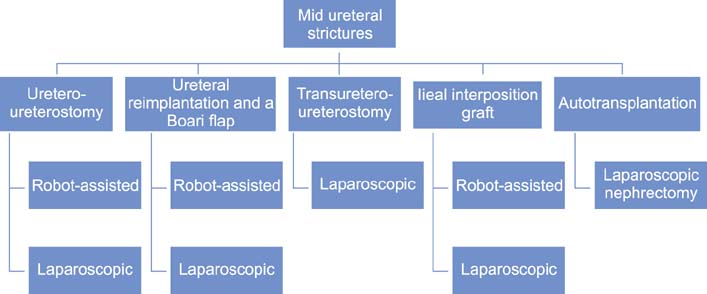Korean J Urol.
2014 Jan;55(1):2-8. 10.4111/kju.2014.55.1.2.
Laparoendoscopic Management of Midureteral Strictures
- Affiliations
-
- 1Department of Urology, Urological Science Institute, Yonsei University College of Medicine, Seoul, Korea. khrha@yuhs.ac
- 2Department of Urology, General Hospital of Nikaia 'St. Panteleimon', Athens, Greece.
- KMID: 1988445
- DOI: http://doi.org/10.4111/kju.2014.55.1.2
Abstract
- The incidence of ureteral strictures has increased worldwide owing to the widespread use of laparoscopic and endourologic procedures. Midureteral strictures can be managed by either an endoscopic approach or surgical reconstruction, including open or minimally invasive (laparoscopic/robotic) techniques. Minimally invasive surgical ureteral reconstruction is gaining in popularity in the management of midureteral strictures. However, only a few studies have been published so far regarding the safety and efficacy of laparoscopic and robotic ureteral reconstruction procedures. Nevertheless, most of the studies have reported at least equivalent outcomes with the open approach. In general, strictures more than 2 cm, injury strictures, and strictures associated either with radiation or with reduced renal function of less than 25% may be managed more appropriately by minimally invasive surgical reconstruction, although the evidence to establish these recommendations is not yet adequate. Defects of 2 to 3 cm in length may be treated with laparoscopic or robot-assisted uretero-ureterostomy, whereas defects of 12 to 15 cm may be managed either via ureteral reimplantation with a Boari flap or via transuretero-ureterostomy in case of low bladder capacity. Cases with more extended defects can be reconstructed with the incorporation of the ileum in ureteral repair.
MeSH Terms
Figure
Reference
-
1. Hafez KS, Wolf JS Jr. Update on minimally invasive management of ureteral strictures. J Endourol. 2003; 17:453–464.2. Nakada SY, Hsu TH. Management of upper urinary tract obstruction. In : Kavoussi LR, Novick AC, Partin AW, Peters CA, editors. Cambpell-Walsh urology. 10th ed. Philadelphia: Elsevier Saunders;2012. p. 1122–1168.3. Wolf JS Jr, Elashry OM, Clayman RV. Long-term results of endoureterotomy for benign ureteral and ureteroenteric strictures. J Urol. 1997; 158(3 Pt 1):759–764.4. Kachrilas S, Bourdoumis A, Karaolides T, Nikitopoulou S, Papadopoulos G, Buchholz N, et al. Current status of minimally invasive endoscopic management of ureteric strictures. Ther Adv Urol. 2013; 5:354–365.5. Parpala-Spårman T, Paananen I, Santala M, Ohtonen P, Hellstrom P. Increasing numbers of ureteric injuries after the introduction of laparoscopic surgery. Scand J Urol Nephrol. 2008; 42:422–427.6. Phillips EA, Wang DS. Current status of robot-assisted laparoscopic ureteral reimplantation and reconstruction. Curr Urol Rep. 2012; 13:190–194.7. Windsperger AP, Duchene DA. Robotic reconstruction of lower ureteral strictures. Urol Clin North Am. 2013; 40:363–370.8. Lee Z, Llukani E, Reilly CE, Mydlo JH, Lee DI, Eun DD. Single surgeon experience with robot-assisted ureteroureterostomy for pathologies at the proximal, middle, and distal ureter in adults. J Endourol. 2013; 27:994–999.9. Nezhat C, Nezhat F, Green B. Laparoscopic treatment of obstructed ureter due to endometriosis by resection and ureteroureterostomy: a case report. J Urol. 1992; 148:865–868.10. Nezhat CH, Nezhat F, Seidman D, Nezhat C. Laparoscopic ureteroureterostomy: a prospective follow-up of 9 patients. Prim Care Update Ob Gyns. 1998; 5:200.11. Simmons MN, Gill IS, Fergany AF, Kaouk JH, Desai MM. Laparoscopic ureteral reconstruction for benign stricture disease. Urology. 2007; 69:280–284.12. Hemal AK, Nayyar R, Gupta NP, Dorairajan LN. Experience with robot assisted laparoscopic surgery for upper and lower benign and malignant ureteral pathologies. Urology. 2010; 76:1387–1393.13. Lee DI, Schwab CW, Harris A. Robot-assisted ureteroureterostomy in the adult: initial clinical series. Urology. 2010; 75:570–573.14. Baldie K, Angell J, Ogan K, Hood N, Pattaras JG. Robotic management of benign mid and distal ureteral strictures and comparison with laparoscopic approaches at a single institution. Urology. 2012; 80:596–601.15. Buffi N, Cestari A, Lughezzani G, Bellinzoni P, Sangalli M, Scapaticci E, et al. Robot-assisted uretero-ureterostomy for iatrogenic lumbar and iliac ureteral stricture: technical details and preliminary clinical results. Eur Urol. 2011; 60:1221–1225.16. Lee Z, Simhan J, Parker DC, Reilly C, Llukani E, Lee DI, et al. Novel use of indocyanine green for intraoperative, real-time localization of ureteral stenosis during robot-assisted ureteroureterostomy. Urology. 2013; 82:729–733.17. Fugita OE, Dinlenc C, Kavoussi L. The laparoscopic Boari flap. J Urol. 2001; 166:51–53.18. Castillo OA, Travassos J, Escobar J F, Lopez-Fontana G. Laparoscopic ureteral replacement by Boari flap: multi-institutional experience in 30 cases. Actas Urol Esp. 2013; 37:658–662.19. Rassweiler JJ, Gozen AS, Erdogru T, Sugiono M, Teber D. Ureteral reimplantation for management of ureteral strictures: a retrospective comparison of laparoscopic and open techniques. Eur Urol. 2007; 51:512–522.20. Schimpf MO, Wagner JR. Robot-assisted laparoscopic Boari flap ureteral reimplantation. J Endourol. 2008; 22:2691–2694.21. Yang C, Jones L, Rivera ME, Verlee GT, Deane LA. Robotic-assisted ureteral reimplantation with Boari flap and psoas hitch: a single-institution experience. J Laparoendosc Adv Surg Tech A. 2011; 21:829–833.22. Musch M, Hohenhorst L, Pailliart A, Loewen H, Davoudi Y, Kroepfl D. Robot-assisted reconstructive surgery of the distal ureter: single institution experience in 16 patients. BJU Int. 2013; 111:773–783.23. Dechet CB, Young MM, Segura JW. Laparoscopic transureteroureterostomy: demonstration of its feasibility in swine. J Endourol. 1999; 13:487–493.24. Piaggio LA, Gonzalez R. Laparoscopic transureteroureterostomy: a novel approach. J Urol. 2007; 177:2311–2314.25. Gill IS, Savage SJ, Senagore AJ, Sung GT. Laparoscopic ileal ureter. J Urol. 2000; 163:1199–1202.26. Wagner JR, Schimpf MO, Cohen JL. Robot-assisted laparoscopic ileal ureter. JSLS. 2008; 12:306–309.27. Netto Júnior NR, Ferreira U, Lemos GC, Claro JF. Endourological management of ureteral strictures. J Urol. 1990; 144:631–634.28. Seseke F, Heuser M, Zoller G, Plothe KD, Ringert RH. Treatment of iatrogenic postoperative ureteral strictures with Acucise endoureterotomy. Eur Urol. 2002; 42:370–375.29. De Cicco C, Ret Davalos ML, Van Cleynenbreugel B, Verguts J, Koninckx PR. Iatrogenic ureteral lesions and repair: a review for gynecologists. J Minim Invasive Gynecol. 2007; 14:428–435.30. Ockerblad NF. Reimplantation of the ureter into the bladder by a flap method. J Urol. 1947; 57:845–847.31. Chung BI, Hamawy KJ, Zinman LN, Libertino JA. The use of bowel for ureteral replacement for complex ureteral reconstruction: long-term results. J Urol. 2006; 175:179–183.32. Kerbl K, Chandhoke PS, Figenshau RS, Stone AM, Clayman RV. Effect of stent duration on ureteral healing following endoureterotomy in an animal model. J Urol. 1993; 150:1302–1305.


